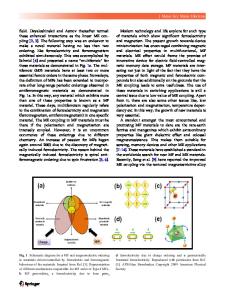Challenges and Opportunities in Multifunctional Nanocomposite Structures for Aerospace Applications
- PDF / 583,037 Bytes
- 7 Pages / 612 x 783 pts Page_size
- 69 Downloads / 404 Views
PMCs are also being increasingly used for space structural applications. PMCs are generally preferred over metals for moderate-temperature applications (⬍300°C), based on their weight savings, fatigue resistance, corrosion suppression, and significantly decreased part count (especially fasteners). Future aerospace systems and current developmental systems seek to further enhance both the mechanical and multifunctional properties of PMCs by incorporating nanoparticles.
Opportunities in Multifunctional Nanocomposite Structures for Aerospace Applications
Property Improvement of Composite Structures with Nanoparticles
Jeff Baur and Edward Silverman Abstract One important application of nanocomposites is their use in engineered structural composites. Among the wide variety of structural applications, fiber-reinforced composites for aerospace structures have some of the most demanding physical, chemical, electrical, thermal, and mechanical property requirements. Nanocomposites offer tremendous potential to improve the properties of advanced engineered composites with modest additional weight and easy integration into current processing schemes. Significant progress has been made in fulfilling this vision. In particular, nanocomposites have been applied at numerous locations within hierarchical composites to improve specific properties and optimize the multifunctional properties of the overall structure. Within this article, we review the status of nanocomposite incorporation into aerospace composite structures and the need for continued development.
Introduction Current advanced engineered materials systems, such as organic-matrix composites, have a myriad of applications including aerospace structures, sporting goods, high-performance automobiles, and boats. Composite aerospace structures often have extreme property demands that make the adoption of higher-performance materials systems, such as nanocomposites, inviting. However, there is also a strong need to balance the multiple demands of performance, weight, processability, risk, and/or life-cycle cost in selecting new structural materials. In this article, we discuss the current and potential impact of nanotechnology
328
on composites, with a particular focus on their relevance to aerospace applications. As air travel continues to grow, lightweight, multifunctional, and easily manufactured structural materials such as polymer matrix composites (PMCs) are being increasingly used. PMCs combat increased fuel and maintenance costs, which account for roughly 50% and 20%, respectively, of the operation costs, beyond ownership, of a commercial airplane.1 Considering that the recent cost of launching a heavy lift system into low Earth orbit2 is $6000–$20,000/kg and approximately $36,000/kg for geosynchronous orbit,3
A particular challenge for traditional composites is the integration, control, and exploitation of nanoparticle-enabled properties within a hierarchical structured composite made with commercially viable processing methods. Although industrial efforts con
Data Loading...











